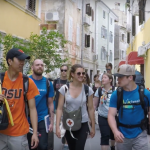
Emily Burkhart, a natural resources student, loves being part of the Oregon State community. As a member of the National Society for Leadership and Success, the Natural Resources Club, an intern at Avery Nature House and student arboretum specialist technician at Peavy Arboretum, she’s always reaching out and getting involved.
During the summer of 2017, Burkhart worked in Starkey Experimental Forest. Research in the riparian forest focuses on small mammals, cow and deer in relation to one another and the ecosystems they inhabit.
“When people think of ecosystem management and habitat relations, a lot of people think of large mammals and carnivores, but what a lot of people don’t realize is that it starts at a smaller level,” Burkhart says.
Burkhart spent two weeks checking about 200 traps every day to collect data on animals to learn about population dynamics in areas near water.
Species analyzed ranged from flying squirrels to jumping mice. The small mammals in these locations eat butterflies and their larvae as a food source, so researchers wanted to know population numbers and the roles they play in the conservation of species.
“Overall I processed and collected data on around 1,054 animals,” Burkhart says. “Once an animal was in a trap, we would tag its ears and collect data on its sex, age, weight, previous captures and reproductive state.”
Burkhart says she learned a lot from the experience and had a great time.
“At Starkey, I got to meet 25-year-old elk, explore Eastern Oregon and understand the importance of small species,” Burkhart says. “My amazing team made it a really great experience.”
Burkhart says she is grateful for her College of Forestry experience and how it opened her eyes to the world around her.
During the summer of 2018, Burkhart took part in a faculty-led study abroad experience to Malaysian Borneo. Back home in Corvallis, she enjoys spending time in the forest.
“We are so lucky to have the College Research Forests only 12 minutes away from campus.
By working at the arboretum, I really learned how these managed forests operate, and how much it gives back to us in research, recreation and pure happiness,” Burkhart says. “People really need to go check out the arboretum at least once in their life because one visit can leave such a positive, everlasting impact.”



